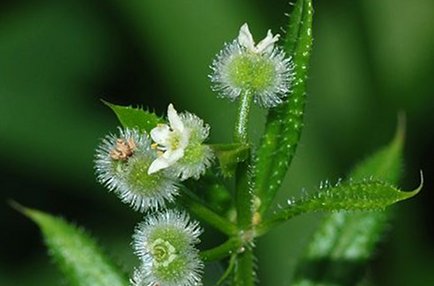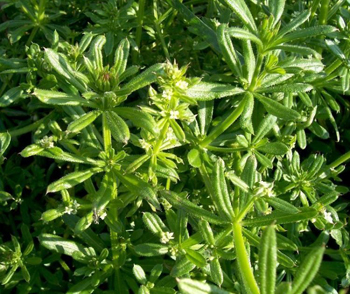Cleavers
(Galium aparine)
Alias names for Cleavers: Galium aparine Family: Rubiaceae, Amor De Hortelano, Aperine, Barweed, Bedstraw, Burwood, Catch weed, Catchweed, Cheese rent herb, Clabber grass, Cleavers Goosegrass, Cleavers, Cleaverwort, Cleever, Clivers, Eriffe, Erriffe, Everlasting Friendship, Galium aparine, Gia Mara, Goose bill, Goose grass, Goose’s hair, Goosebill, Goosegrass, Goose-share, Grateron, Gravel grass, Grip Grass, Hashishat Al Af’A, Hayriffe, Hayruff, Hedge Clivers, Hedgeheriff, Kaz Yogurtotu, Loveman, Milk sweet, Mutton Chops, Poor Robin, Robin-run-in-the-grass, Robin-run-the-hedge, Savoyan, Scratch weed, Scratchweed, Sticky willow, Sticky willy, Stickyweed, Stickywilly, Sticky-willy, Velcro weed, Zhu Yang Yang
Chinese Name for Cleavers: None Found
Pictures of Cleavers:

These sticky little flowers are from the Cleavers plant.

Cleavers sticks to everything–plants, your pants legs–but it’s a great herb for chronic bladder infection.
References for Cleavers pictures:
https://www.bodyenlightenment.me/blog/2011/09/cleavers-an-herb-for-lymphatic-health/
https://medicinalherbinfo.org/herbs/Cleavers.html
About Cleavers: Cleavers is an annual that has square stems and grows up to 4 ft. It has whorls of lance-shaped leaves. The small white flowers grow in clusters that produce a green fruit which has hooked prickles. The plant is common in North America and in Europe, and it can be found in temperate regions of Australia. Cleavers is common along roadsides and can be grown in gardens. Here in Idaho we call it a weed. It grows in well drained neutral to alkaline soil and can be propagated by seed or plant division. The plant is harvested in late spring when it blooms and is dried. It can also be used fresh, juiced or in oil. The ripe seeds and roots are used as well.
Actions and Uses of Cleavers:
• Anti-inflammatory
• Antichloristic (removes bleach from the system—interesting because this herb is used for low-grade bladder infections and chlorine really affects the bladder and male prostate)
• Aperient (mild laxative or purgative)
• Astringent
• Cancer
• Coffee Substitute (I can’t imagine but. . .)
• Cystitis
• Depurative (meaning a purifier)
• Diuretic
• Febrifuge (breaks fevers)
• Glandular Fever
• Gonorrhea
• Hair tonic
• Hepatitis
• Kidney Stones
• Lymphatic system stimulate and cleanser
• Mild laxative
• Skin Conditions–eczema, psoriasis and seborrhea
• Swollen lymph glands
• Tonic
• Tonsillitis
• Ulcers
• Urinary Problems
• Venomous snake and spider bites
• Vulnerary (heals wounds)
• Wounds
How Cleavers is used and how it works:
• Compress soaked in infused cleavers juice is helpful for burns and inflamed skin.
• Cream
• Hair rinse
• Infusion can be used for urinary problems and to reduce fever.
• Juice from the aerial parts of Cleavers is a diuretic and lymphatic cleanser used for treating various cancers, glandular fever, tonsillitis, and prostate problems.
• Tincture can be taken in combination with other herbs such as pokeroot.
• Tea
Parts of the Cleavers plant used: Whole plant
Properties of Cleavers: Acidic, alterative, antitumor, astringent, bitter, cooling, diuretic, laxative, relaxes, spasms, tonic
Chemical Constituents of Cleavers: Anthraquinones (in the root), citric acid, coumarins, flavonoids, glycosides (asperuloside), iridoids, polyphenolic acids (caffeic-acid, gallic acid), tannins
Contradictions, safety issues, concerns, harmful drug interactions and allergy precautions for Cleavers: Cleaver has no known side effects and is said to be safe to use for children and pregnant or nursing women. However, excessive handling of the fresh herb may cause skin irritation.
Helpful Links and References for Cleavers:
• https://altnature.com/gallery/cleavers.htm
• https://www.botanical.com/botanical/mgmh/c/cliver74.html
• https://www.cshs.com/herbsOfMonth/cleavers.html
• https://medicinalherbinfo.org/herbs/Cleavers.html
• Book: Healing Plants of the Rocky Mountains by Darcy Williamson